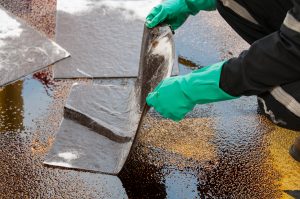How to prepare construction sites for unexpected workplace spills
Spills happen. When they do, what extreme consequences could contractors and workers face? And how can chemical accidents negatively impact construction sites? These are especially important questions for contractors to keep in mind. Because industrial spills, and even stormwater runoff, can have dire consequences for construction environments and workers.
Employees who work with oil, diesel, solvents and other hazardous liquids must respond to spills immediately. These types of spills can affect vegetation, animals, people, and can even make their way into groundwater supplies. To effectively prepare, contractors must outfit their sites with equipment that allows crew members to respond quickly, efficiently, and successfully.
How? At bare minimum, every construction site should contain spill kits. Regardless of whether employees are working in an indoor or outdoor environment, spill kits provide all-in-one solutions to specific spill categories, giving contractors and the builders who work for them peace of mind.
All spills have unforeseen consequences
 Spills left to advance and spread can cost contractors upwards of a hundred thousand dollars in site cleanup fees. That number doesn’t even include potential Environment Protection Agency (EPA) or Occupational Safety and Health Administration (OSHA) fines for violations. In any spill situation, it is the contractor’s responsibility to comply with all local, state, and federal regulatory agency guidelines.
Spills left to advance and spread can cost contractors upwards of a hundred thousand dollars in site cleanup fees. That number doesn’t even include potential Environment Protection Agency (EPA) or Occupational Safety and Health Administration (OSHA) fines for violations. In any spill situation, it is the contractor’s responsibility to comply with all local, state, and federal regulatory agency guidelines.
At construction sites, diesel fuel can present major environmental issues. Contractors who keep diesel containers or vehicles on-site run the risk of developing drips and leaks as well as contaminating nearby water supplies, so proper preparation is imperative.
What kinds of solutions are available?
Spill kits are one way for site managers to easily handle construction site spill response. These kits come in three different categories that are typically color-coded:
- Universal or General Purpose Kits – Include gray absorbents. Use them for cleaning up both water-based fluids and hydrocarbons. Such as oil or diesel from vehicles or construction machinery.
- Oil-Only Kits – Contain white absorbents that repel water, absorbing hydrocarbons only. Because they float, cleanup crews them to absorb oils from contaminated water.
- Hazmat Kits – Feature yellow absorbents designed to clean hazardous and aggressive fluids. Like acids, solvents and other chemicals.
What products should contractors stock?
Contractors may find the perfect tool for diverting pollutants in spill containment berm dikes. They may implement these dikes to direct pollutants away from sewers or other natural bodies of water in cases of diesel leaks or spills. With sizes ranging from 5-foot to 10-foot sections, contractors can use dikes to blockade spills, containing them before they can cause serious damage. Need to do more than contain? Constructed with tough outer mesh encased in superabsorbent polypropylene fillers, site managers can use oil absorbent booms to handle all types of hydrocarbon spills such as gasoline, diesel, or fuel and motor oils while repelling water at the same time.
For smaller spills, oil absorbent pillows or universal absorbent pillows can quickly soak up oil on land or water. Depending on the types of chemical agents on hand, hazmat absorbent pillows can facilitate site leaders in absorbing hazardous or unknown aggressive liquid spills.
As contractors are responsible for maintaining clean construction sites while avoiding environmental damage, even small gestures such as adding cigarette butt receptacles can go a long way. With well-stocked absorbent products and well-trained construction staff, contractors can ensure safety and efficiency on their sites.
Need help selecting the right absorbents for your construction site?
The professionals at AbsorbentsOnline can help! Contact Travis Zdrazil at travis@absorbentsonline.com or (800) 869-9633. You can also check out our handy list of industry-specific spill response and absorbent products for construction sites.
